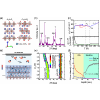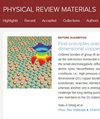用质子演化调节 Ca2RuO4 的电子和磁态
IF 3.4
3区 材料科学
Q2 MATERIALS SCIENCE, MULTIDISCIPLINARY
引用次数: 0
摘要
层状钌酸盐 Ca2RuO4 具有晶格、自旋和电荷自由度之间的强相关性,由于其金属-绝缘体转变、反铁磁-铁磁转变、元磁转变和轨道有序性,在过去几十年中引起了人们的极大兴趣。人们一直致力于通过外延应变、化学置换和压力来操纵其晶体结构,以阐明其潜在的多体物理学和相关的量子临界现象。在此,我们报告了对 Ca2RuO4 薄膜的质子插层综合研究,并探讨了其因结构变形和载流子掺杂而产生的磁传输特性。研究揭示了具有不同电子和磁基态的丰富相图。具体来说,在离子液体浇注过程中,随着栅极电压的增加,薄膜首先从绝缘态演变为金属态,然后逐渐转向奇异的莫特绝缘体。此外,我们还观察到了从斜向反铁磁态到近铁磁态的新兴元磁性转变,这种特征通常由外部磁场触发,但在这里是由电子掺杂触发的。我们的第一原理计算显示,这些意想不到的特征可归因于离子液体浇注过程中质子演化引起的协同结构畸变和电子掺杂。我们的研究结果凸显了晶格和电荷自由度在 Ca2RuO4 奇妙的电子状态中的重要作用,并为揭示量子材料的不同性质提供了一种有效的方法。本文章由计算机程序翻译,如有差异,请以英文原文为准。

Tuning the electronic and magnetic states of Ca2RuO4 with proton evolution
With strong correlations between lattice, spin, and charge degrees of freedom, the layered ruthenate has attracted considerable interest over the past few decades due to its metal-insulator transition, antiferromagnetic-to-ferromagnetic transition, metamagnetic transition, and orbital ordering. Much effort has been devoted to manipulating its crystalline structure through epitaxial strain, chemical substitution, and pressure to clarify the underlying many-body physics and related quantum critical phenomena. Here we report a comprehensive proton intercalation study of thin films and investigate their magneto-transport properties arising from structural deformations and carrier doping. It reveals a rich phase diagram with distinct electronic and magnetic ground states. Specifically, with increasing gate voltage during ionic liquid gating, the film first evolves from an insulating state into a metallic state and then gradually turns towards an exotic Mott insulator. Furthermore, we observed an emergent metamagnetic transition from a canted antiferromagnetic to a nearly ferromagnetic state, a characteristic feature conventionally triggered by external magnetic field, but here with electron doping. Our first-principles calculations reveal that these unexpected features could be attributed to the proton evolution-induced synergistic structural distortion and electron doping during ionic liquid gating. Our findings highlight the important role of both lattice and charge degrees of freedom in the intriguing electronic states of and provide an effective approach to uncover different properties in quantum materials.
求助全文
通过发布文献求助,成功后即可免费获取论文全文。
去求助
来源期刊

Physical Review Materials
Physics and Astronomy-Physics and Astronomy (miscellaneous)
CiteScore
5.80
自引率
5.90%
发文量
611
期刊介绍:
Physical Review Materials is a new broad-scope international journal for the multidisciplinary community engaged in research on materials. It is intended to fill a gap in the family of existing Physical Review journals that publish materials research. This field has grown rapidly in recent years and is increasingly being carried out in a way that transcends conventional subject boundaries. The journal was created to provide a common publication and reference source to the expanding community of physicists, materials scientists, chemists, engineers, and researchers in related disciplines that carry out high-quality original research in materials. It will share the same commitment to the high quality expected of all APS publications.
 求助内容:
求助内容: 应助结果提醒方式:
应助结果提醒方式:


